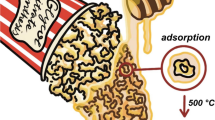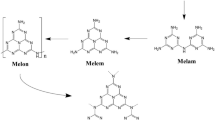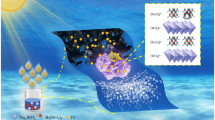Abstract
Low-temperature β-BiNbO4 powders (denoted as Low-β) were prepared by citrate and Pechini methods using homemade water-soluble niobium precursors. The addition of ethylene glycol and the resultant polymerization effect on the synthesis and visible-light photocatalytic performance of β-BiNbO4 powders were fully investigated. The polymerization effect is beneficial to lower the phase formation temperature and obtain smaller particle catalysts. Both methods can synthesize catalysts with excellent performance of visible-light degradation of methyl violet (MV). The Low-β BiNbO4 powder prepared by citrate method shows better degradation rate of about 1 h to decompose 80 % of MV and also displays good photocatalytic stability. The photodegradation of MV under the visible-light irradiation followed the pseudo-first-order kinetics according to the Langmuir-Hinshelwood model, and the obtained first-order rate constant and half-time are 2.85 × 10−2 min−1 and 24.3 min, respectively. The better photocatalytic performance of BiNbO4 powders prepared by citrate method can be attributed to its smaller band gap and better crystallinity.
Similar content being viewed by others
Background
In recent years, environmental pollution, especially organic pollutants, has attracted much attention due to its deleterious effect on human health [1]. TiO2, one of the most popular photocatalysts, can solely absorb ultraviolet (UV) light. In order to make good use of solar light source, many visible-light active photocatalysts have been deeply investigated, such as quantum dot-based photocatalysts [2–5]. Among these photocatalysts, much attention has been paid on bismuth-based photocatalytic materials, such as BiOBr [6, 7], Bi2O2CO3 [8], BiVO4 [9], BiNbO4 [10–12], and BiTaO4 [13, 14], due to their excellent photooxidation ability for organic contaminant degradation via a visible-light photocatalytic process.
BiNbO4 has orthorhombic α and triclinic β phases. In general, the low-temperature α phase synthesized at 900 °C irreversibly transforms to the high-temperature β phase (denoted as High-β) at 1020 °C [15]. While in our former work, we first synthesized the low-temperature β phase (denoted as Low-β) at 700 °C and observed the phase transition from β to α phase [16]. The visible-light photocatalytic performance test also shows that the Low-β exhibits the best photocatalytic efficiency compared with α phase and High-β [12]. The formation of a pure triclinic phase of BiNbO4 at a low temperature of 700 °C can be attributed to the advantage of the citrate method.
The citrate method is a simple way to obtain stable precursors and reactive and stoichiometric fine powders which has been widely used in the fabrication of various simple and complicated oxides [17]. Compared to the citrate method, the Pechini method is superior to obtain a homogeneous multicomponent gel without any phase segregation throughout the processing, which is beneficial to prepared stoichiometric oxides with a much lower temperature and smaller particle size. The difference between these two methods is the introduction of polyhydroxy alcohol, such as ethylene glycol, and the polymerization process between metal citrate and polyhydroxy alcohol. The polymerization results in immobilization of metal complexes in rigid organic polymer nets, thus ensuring the compositional homogeneity [18].
In this work, Low-β BiNbO4 powders were prepared by citrate and Pechini methods using homemade water-soluble niobium precursors. The addition of ethylene glycol and the resultant polymerization effect on the synthesis and visible-light photocatalytic performance of Low-β BiNbO4 powders were investigated, including the phase formation process, particle size, optical properties, and the photocatalytic degradation of methyl violet (MV) under visible light.
Methods
The precursor materials were bismuth nitrate (Bi(NO3)3·5H2O), ammonia, ethylene glycol (EG), and a Nb-citrate (Nb-CA) aqueous solution. The synthesis of water-soluble Nb-CA has been described in detail in a previous work [19]. Low-β BiNbO4 powders were prepared by citrate and Pechini methods. Bi(NO3)3·5H2O was first dissolved in Nb-CA. Then the solution was kept stirring at 60 °C, and ammonia was added to adjust the pH value to 7–8. Finally, a stable solution was obtained. The above is the citrate method process; for the Pechini method, another step is added: after the stable and transparent solution was obtained, EG was dropped as chelating agent and stirring at 80 °C to promote the polymerization between metal CA and EG. The two kinds of solutions were finally dried at 180 °C to evaporate the solvent and calcined at various temperatures from 500 to 900 °C for 3 h with a ramp rate of 3 °C min−1.
The structure of the thermally treated powders was characterized by X-ray diffraction (XRD) with Cu Kα radiation. The grain sizes of the powders were examined using transmission electron microscopy (TEM). The photocatalytic activity of the BiNbO4 powders for the decomposition of MV was evaluated under irradiation of a 150-W Xe lamp at the natural pH value; the details have been described in the previous work, and the degradation process was monitored by an ultraviolet-visible near infrared (UV-vis-NIR) spectrophotometer [12].
Results and Discussion
Figure 1 gives the XRD patterns of BiNbO4 powders prepared by citrate and Pechini methods. In Fig. 1a, it can easily be seen that there is no apparent β-BiNbO4 peaks at 550 °C, only an intermediate phase of Bi5Nb3O15 is formed. With the temperature increase, Bi5Nb3O15 transformed to β-BiNbO4 gradually and pure Low-β BiNbO4 is obtained at 700 °C. Due to the polymerization effect between CA and EG in the Pechini process, the appearance of Low-β BiNbO4 seems much easier, as shown in Fig. 1b. Even at 500 °C, Low-β BiNbO4 has been formed and coexisted with the Bi5Nb3O15 phases. At 550 °C, quite different from that of the citrate method, Low-β BiNbO4 is the major phase and pure Low-β BiNbO4 is also obtained at 700 °C. Low-β BiNbO4 is thermodynamically unstable and transforms to α phase at 900 °C, the same as in other literatures [15]. The differences of the phase formation process can be attributed to the polymerization effect between CA and EG. In the citrate process, the solution consists of Nb-CA and Bi-citrate (Bi-CA) metal complexes and is weakly interconnected by van der Waals or hydrogen bonding; while for the Pechini process, Nb-CA and Bi-CA were coordinated by the polymerization effect between CA and EG to form a homogeneous multicomponent gel, which is crucial for complex oxide preparation [18].
The polymerization is beneficial to obtain smaller particles, as seen in the TEM imagines of Low-β BiNbO4 prepared by the two methods in Fig. 2. The particle size is between 70 and 100 nm for the Pechini method, smaller than that of the citrate method, about 150 nm, while the shape of Low-β BiNbO4 powders seems irregular for both methods due to the uncompleted crystal evolution.
The room-temperature UV-vis absorption spectra of Low-β BiNbO4 powders are recorded in Fig. 3. A pressed BaSO4 powder was used as a reference, and the absorption spectra of the data were transformed from the diffuse reflection spectra according to the Kubelka-Munk (K-M) theory. Because Low-β BiNbO4 is the indirect band gap semiconductor, the relation between the absorption edge and photon energy (hν) can be written as follows:
where A is the absorption constant of the materials of indirect band gap semiconductor. The absorption coefficient (α) is determined from the scattering and reflectance spectra according the K-M theory. The energy band gaps (E g ) of the catalysts prepared by the citrate and Pechini methods are estimated to be 2.85 and 3.1 eV, respectively, based on Eq. (1). It seems that the former catalyst can absorb the visible light better. It is consistent with the appearance of the Low-β BiNbO4 catalyst prepared by the citrate method, which is pale yellow, indicating that this material indeed absorbs the visible light to some extent, while the appearance of the sample prepared by the Pechini method is white. The larger band gap with Low-β BiNbO4 powders prepared by the Pechini method can be attributed to their smaller grain size and insufficient growth of grain.
The visible-light photocatalytic activity of pure Low-β BiNbO4 powders has been investigated under visible-light irradiation (λ > 400 nm), as shown in Fig. 4. MV is adopted as a representative organic dye to evaluate the photocatalytic performance. C 0 is the initial concentration of MV, and C t is the equilibrium concentration of MV at visible-light irradiation time.
For BiNbO4 particles, the mechanism of MV degradation under visible-light irradiation involves photocatalytic and photosensitization pathways, and the latter has a dominant role in the degradation [12]. Both catalysts exhibit excellent performance of visible-light degradation of MV, compared with the degradation of MV without a catalyst. The Low-β BiNbO4 powder prepared by the citrate method shows a better degradation rate of about 1 h to decompose 80 % of MV. The better photocatalytic performance can be attributed to its smaller band gap and better crystallinity than that of catalysts prepared by the Pechini method. Better crystallinity plays an important role in the degradation of MV, corresponding to the adsorption ability test of BiNbO4 powders, as seen in the inset in Fig. 4. Though the catalysts prepared by the Pechini method are with a smaller particle size, the adsorption ability is equal to that of catalysts by citrate method.
In the heterogeneous photocatalytic studies, the photocatalytic degradation rate of the most organic compounds can be described by the modified Langmuir-Hinshelwood kinetics model [20, 21]. The photocatalytic degradation of MV using Low-β BiNbO4 powders obeys the pseudo-first-order kinetics. The representation of the rates of photodegradation of MV is given by
This equation can be modified to demonstrate linearity of data, if the Eq. (2) is given by
where k is the constant of the pseudo-first-order rate.
A plot of ln(C 0/C t) versus the visible irradiation time for the MV photodegradation catalyzed by Low-β BiNbO4 powders is shown in Fig. 5. A linear relation between ln(C 0/C t) and the irradiation time has been confirmed, which implies that the photodegradation of MV follows the first-order kinetics. The obtained first-order rate constant (k) and half-time (t 1/2) are 2.85 × 10−2 min−1 and 24.3 min and 1.87 × 10−2 min−1 and 37 min, respectively. The higher the first-order rate constant is, the more outstanding the photocatalytic performance is. So the degradation of MV using Low-β BiNbO4 powders prepared by the citrate method shows higher k and smaller t 1/2.
The effect of operating parameters such as the amount of catalyst loading, pH value, and the additive H2O2 concentration on the photocatalytic performance of Low-β BiNbO4 powders prepared by the citrate method has been investigated in our former work [12]. It shows that the optimal operation conditions are catalyst loading of 1 g L−1, pH value of 8, and the additive H2O2 concentration of 2 mmol L−1.
To evaluate the reusability and stability of the as-synthesized photocatalysts, five cycles of photodegradation of MV are conducted taking Low-β BiNbO4 powder prepared by citrate method as typical samples. Figure 6 shows no obvious performance loss after five cycling runs of photodegradation of MV, which indicates that the Low-β BiNbO4 photocatalyst is an efficient visible light-driven photocatalyst with good reusability for potential practical applications in wastewater treatment.
Conclusions
Low-β BiNbO4 powders were prepared by citrate and Pechini methods using homemade water-soluble niobium precursors. The addition of ethylene glycol and the resultant polymerization effect on the synthesis and visible-light photocatalytic performance of Low-β BiNbO4 powders were investigated. The polymerization effect is beneficial to lower the phase formation temperature and obtain smaller particle catalysts. Both methods can synthesize catalysts with excellent performance of visible-light degradation of MV. The Low-β BiNbO4 powder prepared by the citrate method shows a better degradation rate of about 1 h to decompose 80 % of MV and also displays good photocatalytic stability. The photodegradation of MV under the visible-light irradiation followed the pseudo-first-order kinetics according to the Langmuir-Hinshelwood model, and the obtained first-order rate constant and half-time are 2.85 × 10−2 min−1 and 24.3 min, respectively. The better photocatalytic performance of BiNbO4 powders prepared by the citrate method can be attributed to its smaller band gap and better crystallinity.
References
Chatterjee D, Dasgupta S (2005) Visible light induced photocatalytic degradation of organic pollutants. J Photochem Photobiol C: Photochem Rev 6:186–205
Roushania M, Mavaeia M, Rajabib HR (2015) Graphene quantum dots as novel and green nano-materials for the visible-light-driven photocatalytic degradation of cationic dye. J Mol Catal A Chem 409:102–109
Rajabib HR, Khanib O, Shamsipurc M, Vatanpourd V. High-performance pure and Fe3+-ion doped ZnS quantum dots as green nanophotocatalysts for the removal of malachite green under UV-light irradiation. J Hazard Mater. 2013;250-251:370-8.
Rajabib HR, Farsi M (2015) Quantum dot based photocatalytic decolorization as an efficient and green strategy for the removal of anionic dye. Mater Sci Semicon Proc 31:478–486
Shamsipur M, Rajabib HR (2014) Study of photocatalytic activity of ZnS quantum dots as efficient nanoparticles for removal of methyl violet: effect of ferric ion doping. Spectrochim Acta Part A Mol Biomol Spectrosc 122:260–267
Huang HW, Han X, Li XW, Wang SC, Chu PK, Zhang YH (2015) Fabrication of multiple heterojunctions with tunable visible-light-active photocatalytic reactivity in BiOBr-BiOI full-range composites based on microstructure modulation and band structures. ACS Appl Mater Interfaces 7:482–492
Guo YX, Huang HW, He Y, Tian N, Zhang TR, Chu PK, An Q, Zhang YH (2015) In situ crystallization for fabrication of a core-satellite structured BiOBr-CdS heterostructure with excellent visible-light-responsive photoreactivity. Nanoscale 7:11702–11711
Huang HW, Li XW, Wang JJ, Dong F, Chu PK, Zhang TR, Zhang YH (2015) Anionic group self-doping as a promising strategy: band-gap engineering and multi-functional applications of high-performance CO3 2−-doped Bi2O2CO3. ACS Catal 5:4094–4103
Park Y, McDonald KJ, Choi KS (2013) Progress in bismuth vanadate photoanodes for use in solar water oxidation. Chem Soc Rev 42:2321–2337
Mukthaa B, Darrietb J, Madrasc G, Row TNG (2006) Crystal structures and photocatalysis of the triclinic polymorphs of BiNbO4 and BiTaO4. J Solid State Chem 179:3919–3925
Ullah R, Ang HM, Tadé MO, Wang SB. Synthesis of doped BiNbO4 photocatalysts for removal of gaseous volatile organic compounds with artificial sunlight. Chem Eng J. 2012;185-186:328-36.
Zhai HF, Li AD, Kong JZ, Li XF, Zhao J, Guo BL, Yin J, Li ZS, Wu D (2013) Preparation and visible-light photocatalytic properties of BiNbO4 and BiTaO4 by a citrate method. J Solid State Chem 202:6–14
Ullah R, Sun HQ, Ang HM, Tadé MO, Wang SB (2012) Photocatalytic oxidation of water and air contaminants with metal doped BiTaO4 irradiated with visible light. Catal Today 192:203–212
Shi R, Lin J, Wang YJ, Xu J, Zhu YF (2010) Visible-light photocatalytic degradation of BiTaO4 photocatalyst and mechanism of photocorrosion suppression. J Phys Chem C 114:6472–6477
Subramanian MA, Calabrese JC (1993) Crystal structure of the low temperature form of bismuth niobium oxide. Mat Res Bull 28:523–529
Zhai HF, Qian X, Kong JZ, Li AD, Gong YP, Li H, Wu D (2011) Abnormal phase transition in BiNbO4 powders prepared by a citrate method. J Alloys Compd 509:10230–10233
Marcilly C, Courty P, Delmon B (1970) Preparation of highly dispersed mixed oxides and oxide solid solutions by pyrolysis of amorphous organic precursors. J Am Ceram Soc 53:56–57
Lin J, Yu M, Lin CK, Liu XM (2007) Multiform oxide optical materials via the versatile Pechini-type sol-gel process: synthesis and characteristics. J Phys Chem C 111:5835–5845
Li AD, Cheng JB, Tang RL, Shao QY, Tang YF, Wu D, Ming NB (2006) A novel simple route to synthesize aqueous niobium and tantalum precursors for ferroelectric and photocatalytic applications. Mater Res Soc Symp Proc 942:0924–W04, 03
Al-Ekabi H, Serpone N (1988) Kinetics studies in heterogeneous photocatalysis. I. Photocatalytic degradation of chlorinated phenols in aerated aqueous solutions over titania supported on a glass matrix. J Phys Chem 92:5726–5731
Kong JZ, Li AD, Li XY, Zhai HF, Zhang WQ, Gong YP, Li H, Wu D (2010) Photo-degradation of methylene blue using Ta-doped ZnO nanoparticle. J Solid State Chem 183:1359–1364
Acknowledgements
This project was supported by the Natural Science Foundation of China (No. 51202107), a grant from the Opening Funding of National Laboratory of Solid State Microstructure (No. M26017), and the Doctoral Scientific Research Foundation of Henan Normal University (No. 5101029170260).
Author information
Authors and Affiliations
Corresponding author
Additional information
Competing interests
The authors declare that they have no competing interests.
Authors’ contributions
HZ carried the main part of the experimental work and XRD measurements and photocatalytic activity test. JK carried TEM image measurements. AW, HL, and TZ participated in the preparation of water-soluble Nb-CA precursors. AL and DW participated in the design of the study and helped to draft the manuscript. All authors read and approved the final manuscript.
Rights and permissions
Open Access This article is distributed under the terms of the Creative Commons Attribution 4.0 International License (http://creativecommons.org/licenses/by/4.0/), which permits unrestricted use, distribution, and reproduction in any medium, provided you give appropriate credit to the original author(s) and the source, provide a link to the Creative Commons license, and indicate if changes were made.
About this article
Cite this article
Zhai, H., Kong, J., Wang, A. et al. The Polymerization Effect on Synthesis and Visible-Light Photocatalytic Properties of Low-Temperature β-BiNbO4 Using Nb-Citrate Precursor. Nanoscale Res Lett 10, 457 (2015). https://doi.org/10.1186/s11671-015-1165-z
Received:
Accepted:
Published:
DOI: https://doi.org/10.1186/s11671-015-1165-z










